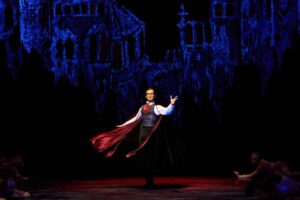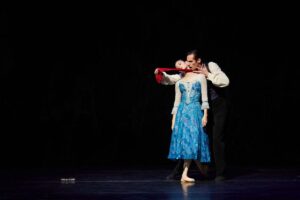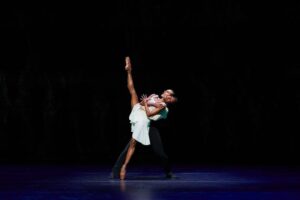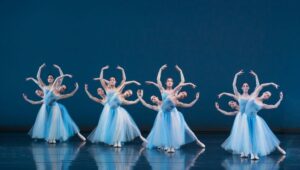From Russia to Romania
Balanchine’s Serenade and Vasterling’s Dracula

Born with the sound of church bells near his home in Bohemia, Bohuslav Martinů’s music was an effective choice for Paul Vasterling’s Dracula. After all, Martinů was born in central Eastern Europe, the same region that gave birth to the Dracula legends. The poignant melodies of his Nocturnes, Pastorales, and Concertino (often featuring Nashville Symphony Principal Cellist Kevin Bate who deserved solo mention) merged with Martinů’s incisive rhythms and haunting harmonies. This music elegantly sheathed Bram Stoker’s Gothic tale of a conflicted spirit. Dracula, the vampire; his flirtatious victim Lucy; Renfield, the crazed acolyte; and the targeted young lovers Jonathan Harker and Mina were joined onstage by a host of the living and the undead skillfully danced by the Nashville Ballet (NB).
The warnings of sex, nudity, and violence were rather oversold as the only nudity was Harker clad in a 19th-century undergarment; a few kisses constituted the sex. Likewise, as with many 19th-century melodramas, the violence is referenced rather than revealed, as in the inventive use of slender red scarves representing the blood from the vampires’ bites. This restraint makes the effect more powerful.

This was the strongest of Vasterling’s works I have witnessed. What worked so well was the fluid fusing of classical ballet, like flurries of bourée steps, with modern dance movements, like sharp angles in the arms. There are definite similarities with the Michel Fokine setting of Igor Stravinsky’s Firebird, especially the use of modern dance elements for the evil, unearthly creatures—Katschei’s creatures in Firebird; Dracula’s undead—when attacking the hero. Even Eric Harris’ bedraggled costumes for the undead served as a flattering tip of the hat to Marc Chagall’s 1945 Firebird costuming.
Vasterling’s choreographic art was especially powerful here with Mina (Jamie Kopit)’s passages delicate and graceful. Lucy (Marissa Stark) moved from innocent flirtation to post-bite sensuality. Dracula, played with stage-ruling authority by Owen Thorne, was given wide open spaces on stage, broadly spreading arms, expansive first-position arabesques, and the wonderfully dramatic use of his swirling red-lined black cape, while Harker (James Lankford)’s moves were appropriately more self-contained.
Only two issues caused a bit of a twinge. Harker’s scene with the undead showed more strength in his movements than one might expect, given his wounded condition. Renfield’s derangement, skillfully rendered by Garritt McCabe, was much more successfully represented in his passages writhing and crawling on the floor. Although this is Gothic horror, the sudden appearance of the massive cross seemed out of balance with the minimalist use of lights and props in the rest of the production.

But these are minor quibbles. The well-deployed use of narration from the dancers, lighting, props, whooshing sound effects with disembodied voices (no one was credited with sound effects), and a live orchestra playing compelling music, succeeded in creating a modern exemplar of Richard Wagner’s Gesamtskunstwerk, a total artwork. This expert fusing of every element of theater gave this work particular strength.
The choice to open the program with an elegant work by Vasterling’s stylistic ancestor, George Balanchine was inspired. For Serenade, the dancers of the Nashville Ballet were coached by Eve Lawson, a répétiteur from the Balanchine Trust, a non-profit dedicated to preserving the integrity of the great choreographer’s works. The corps de ballet work was some of the finest I’ve seen from the company.

As for the work itself, his first choreography upon immigrating to the USA, Balanchine’s clever use of a non-narrative piece by Tchaikovsky, a composer renowned for classical dance’s strongest narrative ballets remains deeply moving, the best of both worlds. The vision of choreographing an instrumental work from the composer of Nutcracker and Swan Lake can never be understated, nor can Balanchine’s gorgeous delicacy and velvety synthesis of classical and modern techniques with a touch of his signature humor.
This was indeed a night to be remembered, opening one of Nashville’s strongest years of dance in living memory. Other performances by NB, along with the TPAC International Dance series, and avant-garde works at OZ Arts should keep dance lovers gratified throughout the 2024-2025 season.



